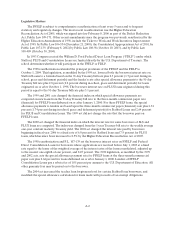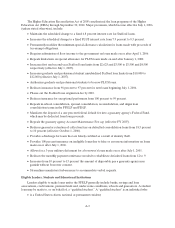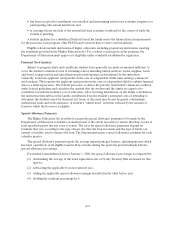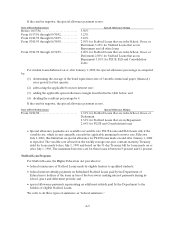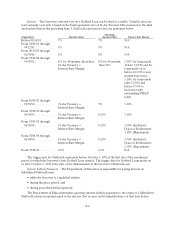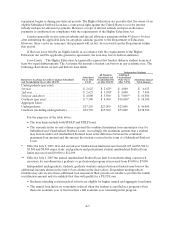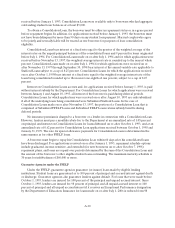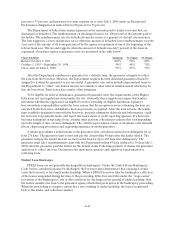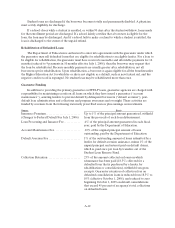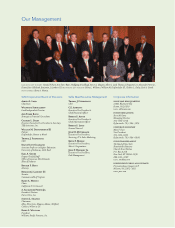Sallie Mae 2005 Annual Report Download - page 207
Download and view the complete annual report
Please find page 207 of the 2005 Sallie Mae annual report below. You can navigate through the pages in the report by either clicking on the pages listed below, or by using the keyword search tool below to find specific information within the annual report.
A-9
Until July 1, 2001, the 1-year index was the bond equivalent rate of 52-week Treasury bills auctioned at the
final auction held prior to each June 1. Beginning July 1, 2001, the 1-year index is the weekly average
1-year constant maturity Treasury yield determined the preceding June 26.
Trigger Date Borrower Rate
Maximum
Borrower Rate
Interest
Rate
Margin
Before 10/01/81 ................. 9% 9% N/A
From 10/01/81 through 10/30/82. . . 14% 14% N/A
From 11/01/82 through 06/30/87. . . 12% 12% N/A
From 07/01/87 through 09/30/92. . . 1-year Index + Interest Rate Margin 12% 3.25%
From 10/01/92 through 06/30/94. . . 1-year Index + Interest Rate Margin PLUS 10%, SLS 11% 3.10%
From 07/01/94 through 06/30/98. . . 1-year Index + Interest Rate Margin 9% 3.10%
From 6/30/98 through 06/30/06.... 91-day Treasury + Interest Rate Margin 9% 3.10%
From 07/01/06 .................. 8.5% 8.5% N/A
For PLUS and SLS Loans made before October 1, 1992, the trigger date is the first day of the
enrollment period for which the loan was made. For PLUS and SLS Loans made on or after October 1,
1992, the trigger date is the date of the disbursement of the loan.
A holder of a PLUS or SLS Loan is eligible to receive special allowance payments during any quarter
if:
•the borrower rate is set at the maximum borrower rate and
•the sum of the average of the bond equivalent rates of 3-month Treasury bills auctioned during that
quarter and the applicable interest rate margin exceeds the maximum borrower rate.
Effective July 1, 2006, this limitation on special allowance for PLUS loans made on and after January 1,
2000 is repealed.
Repayment, Deferments. Borrowers begin to repay principal of their PLUS and SLS Loans no later
than 60 days after the final disbursement. Deferment and forbearance provisions, maximum loan
repayment periods and minimum payment amounts for PLUS and SLS Loans are the same as those for
Stafford Loans.
Consolidation Loan Program
The Higher Education Act also authorizes a program under which borrowers may consolidate one or
more of their student loans into a single Consolidation Loan that is insured and reinsured on a basis
similar to Stafford and PLUS Loans. Consolidation Loans are made in an amount sufficient to pay
outstanding principal, unpaid interest, late charges and collection costs on all federally reinsured student
loans incurred under the FFELP that the borrower selects for consolidation, as well as loans made under
various other federal student loan programs and loans made by different lenders. Under this program, a
lender may make a Consolidation Loan to an eligible borrower who requests it so long as the lender holds
all the outstanding FFELP loans of the borrower (known as the “Single Holder Price”); or the borrower
has multiple FFELP loan holders or his holder does not offer Consolidation Loans. In general, a
borrower’s eligibility to consolidate FFELP student loans ends upon receipt of a Consolidation Loan.
Under certain circumstances, a FFELP borrower may obtain a Consolidation Loan under the FDLP.
Consolidation Loans made on or after July 1, 1994 have no minimum loan amount, although
Consolidation Loans for less than $7,500 do not enjoy an extended repayment period. Applications for
Consolidation Loans received on or after January 1, 1993 but before July 1, 1994 were available only to
borrowers who had aggregate outstanding student loan balances of at least $7,500. For applications





